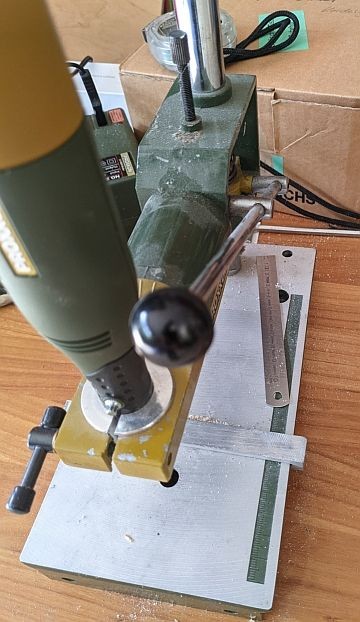One of the fruits of the EuroWeb Cost Action is the freshly-published thematic dossier in the open access journal Ophiussa. Some of the talks presented in May 2022 in the conference in Muro Leccese are collected and published here - and the texts are, at least partly, in English, so don't be scared off by the Portuguese titles in the website and dossier contents.
Search the Blog
Latest Comments
After looking for so long for a replacement for my dearly beloved FotoAlbum software, I think I have now found the winner: It is Tropy, from tropy.org. There's still a few things I have to find out how to handle in the new software, but I have sorted out the importing sequence (and that's actually rather simple) and will be able to keep everything, including my dates. There will be some more tests to make sure everything will be in the new place as it should be, but then I should be fine with the new software.
Here's a screenshot of the current small test run:
Another thing to take a look at, and figure out, is the lists of controlled vocabulary that can be linked up with tropy, and then choose appropriate ones.
But I'm really, really happy that it looks like I'll be able to shift everything to the new place! It's currently 84,654 images in the database, and while not all of them are fully equipped with keywords and a description, enough of them are to make migration in any other way than one big database export, tweak, and import a nightmare.
All the other programmes I've looked at were either not able to import my things (or, to put it properly, making the migrationary tweak was too complicated for me), or they were cloud-based with very limited storage space (we're looking at more than a terabyte here already, so 50 GB free will just make me snort and move on), or really pricey. Or a combination of several of the above.
I will keep you updated on my progress!
On the journey back home from Uppsala, I stumbled across a nice and helpful website if you're planning to travel by train: zugfinder.net. It lets you search for a specific train (like, say, the EN 346) and shows how much and how often that train was delayed in the past 30 days. That could have been very helpful indeed for my plans!
You can also see what train is where just now, in case you are looking for a specific one.
I've had a wonderful, if quite short, time in Uppsala at the Material Literacy workshop. It was planned as a rather short stint, but ended up being even shorter due to a massive train delay. Fortunately I could follow the part I'd have missed otherwise on Zoom!
It was wonderful to meet some old friends and colleagues again, and meet new people. There were fruitful discussions and lots of looks in detail at wonderful textiles. Hopefully there will be more on the topic of material literacy - I think it's a very helpful term for being able to read objects, and having some properly structured, thought-out lessons or schooling on that will surely be very useful for many people.
We finished with a little excursion into the church museum, and I was very happy to see the Golden Gown again.. It's been so many years since I was there last.
On the way back, there was time for a short stroll through Stockholm (well, some of it!) and a bit of food shopping before going back in the night train. I managed to find a nice small Christmas market there, so back at home, we were able to enjoy some freshly imported ostkaka:
I had not heard of that before coming across it on the Christmas market, but I got to try it there, and it was very nice. It's served warm, with the option of adding whipped cream and jam or something fruity, which we did when we had it here. Definitely recommend it!
The way back had just a little delay overall, so I was home in the afternoon, one hour later than planned originally. Now there's no travel until the end of the work year... which is also nice. There's a stack of things waiting to go to the post tomorrow morning, and I'm looking forward to doing some maintenance work during the winter break. The cat also approves to have her cuddle spot on the desk appropriately staffed again!
Margarita Gleba has organised a zoom Study Day for textile archaeology - you can join online!
It starts at 15:00 and goes until 18:00, and you can register via this form here (or click the image).
Yesterday's blog post fell by the wayside - I was away all day going to set up the loom for the exhibition in Bamberg... and it was great fun. (I also learned a lot! Including a new knot, which is actually a big deal for me, as I seem to be a bit of a knot dyslexic sometimes.)
The loom standing in the exhibition now was the result of a lot of thinking, planning, and the effort of many people. Our idea was to show something about weaving in the era around 1000. Now... that's the time when there's already an inkling of the horizontal loom, but we have next to no good evidence for that (as in "good enough to build a reconstruction from"). So we decided to make a warp-weighted loom.
The original plan was to have a regular one, but the building (which is old) does not allow for a loom to touch the walls. (That's also a possible security issue in an exhibition, as a loom only leaning might fall, and attaching it to the wall was out of the question, as the building itself is under heritage protection). The second plan, having an iron/metal holder for the loom, was out because of budget reasons, so we did end up with a free-standing wooden loom.
It's a proper, nice one, though, not looking as if somebody went collecting a few sticks in the wood and cobbled them together.
(The curious thing is that you can build a functional loom from mostly odd sticks from the woods, provided you make sure that the essential bits that need to be straight are straight. That's harder to do nowadays, though, than making one from cured, available, straight bits of wood, though. So that's what we have.)
The main thing that we wanted to do with the loom was to show that textile production at that time was a high-standing, important, and highly developed part of production, and the resulting objects were of high quality. So we found an expert in warp-weighted loom weaving in Sweden - Marie Wallenberg - who worked together with us to get the idea across to the woodworker, who made an almost perfect loom. One of the folks from Kaptorga made the loomweights (scaled down a little to be lighter, because that helps to not wear out the threads over time - the normal fitted loom is not intended to stay for months or years with the loomweights hanging), and Marie wove a fabric to fill the loom.
If you've seen warp-weighted looms in exhibitions, they are often a crooked thing, with a crooked bit of coarse weaving on them. While that may have happened occasionally, it is not what we would expect them to be in general - after all, they were used to make fine, straight, high-quality fabrics in the past. And that is exactly what we wanted to portray.
So once the loom had arrived from the woodworker and the fabric had arrived from Sweden and I had finished making the Rod of Many Holes to attach the weave to the loom's top beam, I set out to set things up in Bamberg, with Marie coaching me through the process.
And now we have a "little clay army" (my new favourite expression for clay weights hanging on the loom) and a white wool waterfall, showing off nicely that yes, you can weave a fine 2/2 twill on a warp-weighted loom. I really love the beautiful starting border as well!
The exhibition will be open from October 25, and even though the info page is German only, the exhibition itself and the catalogue are fully bilingual German and English.
One of the things I really love about my line of work? Getting to work with professionals from adjacent fields and learning new things. Another thing I love is getting to work with many different materials - especially since I'm also working with textile techniques and tools, that does not just encompass the many different variations of fibres, yarns, and fabrics, but also other materials. Wood. Clay. Metal.
It has definitely proven helpful to have a little bit of basic skill working with these things, and a small but versatile selection of tools. One of my favourite ones: The so-called "Bssst". (You may guess why it's called that.)
I have this stand and another stand/holder for it, and it's been drilling holes and polishing things for me a lot. (My dad bought the original Bssst many years ago, and I've just recently had to replace it with a new one, as it absolutely refused to do anything anymore.)
This time, it was my little helper drilling many, many holes in a stick:
That will be the connecting part between the horizontal top beam of a warp-weighted loom and the fabric. While it's technically possible to sew the fabric starting band directly to the top beam, adding in the Stick Of Many Holes makes things easier, and more comfortable, and uses less string overall. The larger holes are to attach the stick to the beam, and the smaller holes to sew the fabric to the stick.
That will happen on Monday - and I'm already looking forward to that!











